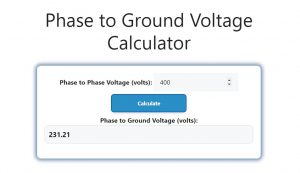About Phase to Ground Voltage Calculator (Formula)
The Phase to Ground Voltage Calculator is a critical tool in electrical engineering that allows professionals to convert phase-to-phase voltage into phase-to-ground voltage. This conversion is essential for understanding how electrical systems operate, particularly in three-phase systems commonly used in industrial and commercial applications. By accurately determining the phase-to-ground voltage, engineers can ensure that electrical components are adequately rated, enhancing safety and efficiency in electrical installations.
Formula
The formula for calculating phase to ground voltage is:
Phase to Ground Voltage (Vp-g) = Phase to Phase Voltage (Vp-p) / √3
Where:
- Phase to Ground Voltage (Vp-g) is the voltage measured from any phase to the ground.
- Phase to Phase Voltage (Vp-p) is the voltage measured between any two phases in a three-phase system.
- √3 is the square root of three, approximately equal to 1.732.
How to Use
- Gather Data: Measure or obtain the phase-to-phase voltage in your electrical system.
- Input Values: Enter the phase-to-phase voltage into the Phase to Ground Voltage Calculator.
- Calculate: The calculator will apply the formula to determine the phase-to-ground voltage.
- Review Results: Analyze the calculated phase-to-ground voltage to ensure that electrical components are rated appropriately.
Example
For instance, if the phase-to-phase voltage in a three-phase system is 400 volts:
- Phase to Phase Voltage (Vp-p): 400 volts
- Calculate Phase to Ground Voltage (Vp-g):
- Phase to Ground Voltage (Vp-g) = 400 volts / √3
- Phase to Ground Voltage (Vp-g) ≈ 400 volts / 1.732
- Phase to Ground Voltage (Vp-g) ≈ 230.94 volts
In this example, the phase-to-ground voltage is approximately 230.94 volts.

FAQs
- What is phase to ground voltage?
Phase to ground voltage is the voltage measured from any phase of a three-phase system to the ground. - Why is it important to calculate phase to ground voltage?
It ensures that electrical equipment is appropriately rated for safety and performance in electrical systems. - What does Vp-p represent?
Vp-p represents the voltage measured between any two phases in a three-phase electrical system. - How does the formula work?
The formula divides the phase-to-phase voltage by the square root of three to find the voltage to ground. - Can phase to ground voltage exceed phase to phase voltage?
No, phase to ground voltage is always less than or equal to phase to phase voltage in balanced systems. - What is the significance of √3 in the formula?
The √3 factor arises from the geometry of three-phase systems and is essential for accurate voltage conversion. - Is this calculator applicable only to three-phase systems?
Yes, this calculator is specifically designed for three-phase electrical systems. - How can I ensure accurate voltage measurements?
Use calibrated measuring equipment and follow proper electrical measurement protocols. - What is the typical phase-to-phase voltage in commercial systems?
Common values include 400V, 480V, or 600V, depending on the region and application. - How does grounding affect electrical systems?
Grounding provides a reference point for voltages and enhances safety by preventing electrical shocks. - Can I use this calculator for single-phase systems?
No, this calculator is specifically intended for three-phase systems. - What are the consequences of incorrect voltage ratings?
Incorrect ratings can lead to equipment failure, safety hazards, and system inefficiencies. - What other calculations are important in electrical engineering?
Other important calculations include current, power factor, and load calculations. - Is there a difference between line-to-neutral and phase-to-ground voltage?
No, in a balanced three-phase system, line-to-neutral voltage is equivalent to phase-to-ground voltage. - How often should I check phase-to-ground voltage?
Regular checks are recommended, especially in critical systems or before maintenance work. - What safety measures should I take when measuring voltages?
Always follow safety protocols, use insulated tools, and wear appropriate personal protective equipment. - Can environmental factors affect voltage measurements?
Yes, factors such as temperature and humidity can impact electrical properties and measurements. - What should I do if the calculated phase to ground voltage is too high?
Investigate potential issues in the system, including equipment ratings and grounding connections. - Are there any online resources for learning more about electrical systems?
Yes, many organizations and educational institutions offer courses and resources on electrical engineering topics. - How does the phase to ground voltage relate to overall system efficiency?
Accurate voltage ratings contribute to the efficiency and reliability of electrical systems, reducing losses and preventing failures.
Conclusion
The Phase to Ground Voltage Calculator is an essential tool for electrical engineers and technicians, facilitating accurate conversions between phase-to-phase and phase-to-ground voltages. By understanding and applying this calculation, professionals can ensure the safe and efficient operation of electrical systems, ultimately leading to better performance and reliability. Regular use of this calculator promotes safety in installations and helps in maintaining compliance with industry standards.